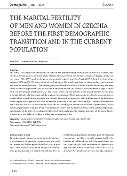The Marital Fertility of Men and Women in Czechia before the First Demographic Transition and in the Current Population

Publication date
2024Published in
DemografieVolume / Issue
66 (2)ISBN / ISSN
ISSN: 0011-8265ISBN / ISSN
eISSN: 1805-2991Metadata
Show full item recordCollections
This publication has a published version with DOI 10.54694/dem.0339
Abstract
The aim of this study is to analyse the changes in the marital fertility of men and women in Czechia before the first demographic transition (data obtained by excerpting the parish registers of Škvorec manor in the years 1760-1839) and in the current population (data from the Czech GGS II based on interviews between 2020 and 2022) using a unified methodology. The results confirm previous findings on historical and modern marital fertility - determining the overall intensity of marital fertility by the duration of marriage in the historical population, the decrease in marital fertility by the decrease in the number of higher-order births in the modern population, etc. The results show that the timing of the first childbirth in marriage is similar in both (the historical and the modern) populations. Historical marriages with the same number of children have a much shorter reproductive window than modern marriages, with no differences at the beginning of the reproductive period, but with differences especially at the end. The timing of reproduction (median age at birth of the first child) does not differ for first marriage in modern and historical populations. In the historical population, women's fertility was limited at a lower age than men's fertility. In the modern population, the intensity of fertility by sex does not differ. In both populations the median duration of the reproductive window does not differ according to either sex or marriage order.
Keywords
marital fertility, first and second demographic transition, female and male fertility
Permanent link
https://hdl.handle.net/20.500.14178/2606License
Full text of this result is licensed under: Creative Commons Uveďte původ-Neužívejte dílo komerčně-Zachovejte licenci 4.0 International






